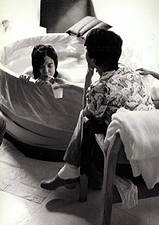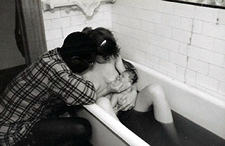FREQUENTLY ASKED QUESTIONS
Is every woman a candidate for a waterbirth?
So long as there are no medical contra-indications, any woman is a possible candidate for a waterbirth. Once health concerns are set aside, it is important to think (and be realistic) about your philosophies, thoughts, and fears relating to birth. This realistic appraisal will be helpful in assessing whether you might be a realistic candidate for a waterbirth. It is best to set-up an appointment with a waterbirth consultant/doula.
What's the difference between water immersion and waterbirth?
Water immersion means that the woman labors in water, but gets out of the tub to deliver the baby. Waterbirth means that the woman labors in the water and delivers the baby into water.
Where can you do a water immersion or waterbirth? You can do a water immersion or waterbirth at home, in a hospital, at a birth center, or in the ocean.
What are the most common reason women want to labor and/or give birth in water?
The most common reason women like the water is because it feels good. Water helps women cope with the sensations and surges of labor and birth. Many women report that the water enables them to override the epidural. In fact, when speaking with a woman whose labor I attended, I noted, "From my observations of you during labor, if you had not had the tub available, I believe there was an 80 percent chance you would have gotten an epidural." "Eighty!" She exclaimed back, "200 percent I would have gotten the epidural. The water saved me."
What is the appropriate temperature for the water?
The water should not exceed the body temperature, which is approximately 97 degrees Fahrenheit (37 degrees Celsius). Temperatures exceeding this level can lead to hyperthermia and dehydration in the mother and the baby.
When should I get into the tub?
Before getting into the tub, it is recommended that you wait until your contractions are strong and consistent, which occurs around 5 centimeters. Some women have utilized the water for rest and regeneration in early labor (before 5 centimeters,) if there has been a long prodromal stage. (Irregular contractions, with a small amount of dilation or none at all.)
Ideally, deep immersion is a key factor. If the bath or pool is not deep enough, up to breast level and completely covering the belly, then the benefits may be less noticeable. Full immersion promotes more physiological responses, the most notable being a redistribution of blood volume, which stimulates the release of oxytocin and vasopressin.
How long should I stay in the water?
Most studies have indicated staying in the water for an hour or two. Twenty minutes in the bath is not enough for the physiologic responses to work effectively. Primips (first time) and multips (multiple births) can get into the water at 7 cm or 8 cm dilation and begin to experience pushing urges within the first hour of immersion. If the contractions begin to space out and slow down, it is advisable to get out of the tub and become ambulatory.
Will I be able to switch positions while in the tub?
You are encouraged to try different positions and to do what works best for you at the time. You are much more able to switch positions with less effort while in the water than on land.
Can my husband/partner get in the tub with me?
Another person can get into the tub with you. If the father or anyone else gets in the tub, make sure they have showered and are not harboring any staff infections on their bodies. Make sure the tub is filled with less water, since the water level increases 1" to 2" for every person in the tub. Some women prefer that their partners support them from outside the tub, while others like their partner to join them in the water.
Can I drink while I am in the tub?
It is imperative the woman and her attendants drink fluids with glucose while in the birth room. Dehydration of the mother leads to low blood volume and could possibly result in orthostatic hypotension, passing out when standing up to get out of the pool.
Is there a risk of infection for the baby?
So long as you clean the tub beforehand, use clean water, a new hot water hose and a disposable tub liner (if your tub calls for one,) risk of infection is small. Because the mother and the baby share the same antibodies, there is no risk of the baby "catching" anything from the mother. Note, however, that if the water has been in the tub for more than 24 hours change the water as a sanitary precaution.
Is there a risk of infection for the mother?
There is little known risk of infection to the mother. Water also dissipates bacteria so pathogens would more than likely be weaker in the water. Since the baby is moving downward and out of the birth canal, it does not follow logically that bacteria can travel upward and into the birth canal. A mother is more apt to get an infection from too many vaginal exams; probes, Aminihooks or scalp hooks before laboring in water after her membranes have ruptured.
What if debris gets in the water during labor?
If birth or fecal matter enter the water, use a scooper (available at most pet supply stores or in your tub kit) for removal.
 Is
it safe to urinate and/or have a bowel movement in the tub?
Is
it safe to urinate and/or have a bowel movement in the tub?
Urine is a sterile substance, so it is permissible for the laboring woman to urinate in the water. Birth attendants and partners, however, should get out of the tub and use the bathroom. It is also permissible to release a bowel movement in the water (and this may very well happen during the third stage of labor). Remove the fecal matter from the water with a scooper as soon as possible.
What are the contraindications (risks) for a water immersion or birth for mother and baby?
*See BENEFITS/RISKS section in website.
How does the baby breathe if it is born into water?
There are 5 inhibitory factors, which prevent a baby from inhaling water when born:
1. The baby in utero is oxygenated through the umbilical cord via the placenta. When a baby breathes air, the intercostal muscles and diaphragm move in a regular and rhythmic pattern. 24 to 48 hours before the onset of labor the prostaglandin E2 levels form the placenta cause a slowing down or stopping in the fetal breathing movements (FBM). The diaphragm and intercostal muscles become suspended and there is a decrease in the FBM. At the birth, the baby's muscles for breathing simply don't work.
2. Babies are born experiencing acute hypoxia or lack of oxygen. This is built in response to the birth process. Hypoxia causes apnea and swallowing, not breathing or gasping.
3. The temperature differential is another factor. When a baby is born into water so close to maternal temperature the baby doesn't detect a change so no breathing is initiated. In some places where an oceanbirth occurs, the water is much cooler than maternal temperature. This is an area for reconsideration since lower temperatures do not seem to stimulate the baby to breathe while immersed either.
4. Water is a hypotonic solution and lung fluids present in the fetus are hypertonic. Hypertonic solutions are denser and prevent hypotonic solutions from merging or coming into their presence. Thus, as water passes through the larynx it does not pass into the lungs.
5. The 'mammalian dive or autonomic reflex' built into all newborns is present at birth and mysteriously disappears around 6 to 8 months. This reflex is associated with the taste buds along the larynx. When a solution hits the back of the throat and crosses the larynx, the taste buds interpret what substance it is and the glottis automatically closes: the solution is then swallowed, not inhaled.
(*These five inhibitory factors are from Waterbirth Basics, From Newborn Breathing to Hospital Protocols by Barbara Harper, Midwifery Today with International Midwife, Summer 2000, Number 54. www.midwiferytoday.com)
It has been discovered newborns exposed to water training up to 8 months after birth are able to avoid atrophy of the mammalian dive reflex.
(Waterbirth
and the Emergence of the Newborn, by Marina Alzugaray, CNM,
Midwifery Today with International Midwife, Summer 2000, Number
54. www.midwiferytoday.com)
 When
should the baby be lifted from the water?
When
should the baby be lifted from the water?
The baby should be gently lifted from the water as soon as the entire body is born. The reasoning behind this is, if the placenta separates quickly and the baby remains under water, oxygen to the baby may be compromised. If she desires, the new mother can reach down and lift the baby up to her chest. Alternatively, the father/partner or midwife may lift the baby up as well. It is important to lift the baby slowly so as not to accidentally tear a short cord.
Can I birth the placenta into water?
This is a matter to discuss with your individual medical caregiver. Some women choose to birth their placentas into water in order to extend the bonding with their babies. Make sure there is an adequate sized 'waiting bowl' to hold the placenta as it floats in the water, attached to the cut or uncut umbilical cord. However, if the mother remains in the water and the placenta takes too much time to present (this is relative to your caregiver perception of time,) it is best to get out of the tub.
Is it important that the doula I hire is not highly experienced in waterbirth or water labor?
There is so much information made readily available to the public on water labor and water birth that it is relatively easy and worthwhile for doulas to read up and educate herself. The Internet, books, articles, magazines, and videos offer a plethora of information. Going to a "Waterbirth Consultant" for a consultation is also advisable. It is most important you have a strong connection with the doula who will attend your birth. Educating and participating is a moment to momentexperience.
Why aren't there more hospitals in the Untied States offering waterbirth?
In the past five years, (1995-2000) there have been great advances in the United States. The U.S. movement is at least five years behind the European movement in acceptance in hospital environments. Midwives and homebirth in the U.S. have been offering waterbirth longer than most of the European counterparts. The United Kingdom has government-sponsored research and data reporting as well as the Cumberledge Report. The states that have made the most progress in the U.S. are: Illinois, Ohio, New York, New Hampshire, North Carolina, Massachusetts, and Maine. The East Coast is changing faster than the West Coast. California has only a handful of hospitals that provide waterbirth services.


